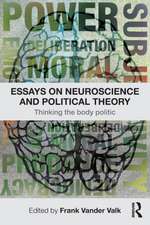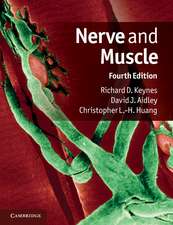Translational Stroke Research: From Target Selection to Clinical Trials: Springer Series in Translational Stroke Research
Editat de Paul A. Lapchak, John H. Zhangen Limba Engleză Hardback – 23 mar 2012
| Toate formatele și edițiile | Preț | Express |
|---|---|---|
| Paperback (1) | 1087.32 lei 38-45 zile | |
| Springer – 23 aug 2016 | 1087.32 lei 38-45 zile | |
| Hardback (1) | 1252.76 lei 6-8 săpt. | |
| Springer – 23 mar 2012 | 1252.76 lei 6-8 săpt. |
Preț: 1252.76 lei
Preț vechi: 1527.75 lei
-18% Nou
Puncte Express: 1879
Preț estimativ în valută:
239.71€ • 250.28$ • 198.39£
239.71€ • 250.28$ • 198.39£
Carte tipărită la comandă
Livrare economică 04-18 aprilie
Preluare comenzi: 021 569.72.76
Specificații
ISBN-13: 9781441995292
ISBN-10: 1441995293
Pagini: 948
Ilustrații: XXIV, 923 p.
Dimensiuni: 155 x 235 x 56 mm
Greutate: 1.45 kg
Ediția:2012
Editura: Springer
Colecția Springer
Seria Springer Series in Translational Stroke Research
Locul publicării:New York, NY, United States
ISBN-10: 1441995293
Pagini: 948
Ilustrații: XXIV, 923 p.
Dimensiuni: 155 x 235 x 56 mm
Greutate: 1.45 kg
Ediția:2012
Editura: Springer
Colecția Springer
Seria Springer Series in Translational Stroke Research
Locul publicării:New York, NY, United States
Public țintă
Upper undergraduateCuprins
Vascular Targets For Ischemic Stroke Treatment.- Identifying Vascular Targets to Treat Hemorrhagic Stroke.- Experimental Platforms For Assessing White Matter Pathophysiology In Stroke.- Neuroprotection in Stroke.- Protein Aggregation And Multiple Organelle Damage After Brain Ischemia.- Antioxidants And Stroke. Success And Pitfalls.- Caspase-Independent Stroke Targets.- Hypoxia-Inducible Factor: A New Hope To Counteract Stroke.- Thrombin in Ischemic Stroke Targeting.- Toll-Like Receptor Agonists As Antecedent Therapy For Ischemic Brain Injury: Advancing Preclinical Studies To The Nonhuman Primate.- Angiogenesis and Arteriogenesis As Stroke Targets.- Hematopoietic Growth Factor Family For Stroke Drug Development.- Soluble Epoxide Hydrolase As A Stroke Target.- Membrane Potential As Stroke Target.- Hypothermia To Identify Therapeutic Targets For Stroke Treatment.- Stroke Preconditioning To Identify Endogenous Protective Or Regenerative Mechanisms.- MicroRNAs in Ischemic Brain: The Fine-tuning Specialists and Novel Therapeutic Targets.- Neuroglobin: A Novel Target For Endogenous Neuroprotection.- Characterization Of Novel Neuroprotective Lipid Analogues For The Treatment Of Stroke.- Na+/H+ Exchangers As Therapeutic Targets For Cerebral Ischemia.- Iron as a therapeutic target in intracerebral hemorrhage: Preclinical testing of deferoxamine.- Overcoming Barriers To Translation From Experimental Stroke Models. Animal Models Of Stroke For Preclinical Drug Development: A Comparative Study Of Flavonols For Cytoprotection.- Clinical Relevance In A Translational Rodent Model Of Acute Ischemic Stroke: Incorporating The Biological Variability Of Spontaneous Recanalization.- A Clinically Relevant Rabbit Embolic Stroke Model For Acute Ischemic Stroke Therapy Development: Mechanisms & Targets.- Animal Models of Intracranial Aneurysm for treatment.- Animal Models of SAH and Their Translation toClinical SAH.- ADME (Absorption, Distribution, Metabolism, Excretion) - The Real Meaning - Avoiding Disaster and Maintaining Efficacy for Preclinical Candidates.- CeeTox Analysis to De-risk Drug Development: The Three Antioxidants (NXY-059, RADICUT and STAZN).- Site-Specific, Sustained-Release Drug Delivery for Subarachnoid Hemorrhage.- Therapeutic Potential of Intranasal Delivery of Drugs and Cells for Stroke and other Neurological Diseases.- High-Dose Albumin For Neuroprotection In Acute Ischemic Stroke: From Basic Investigations To Multicenter Clinical Trial.- The Translation Procedure Of Low-Level Laser Therapy In Acute Ischemic Stroke- A Non-Pharmaceutics Noninvasive Method.- Use Of Microbubbles In Acute Stroke.- Combination of High-Intensity Focused Ultrasound and Microbubbles for Stroke Treatment.- Cellular Therapy for Ischemic Stroke.- Clinical Trial Design and Repair-Based Therapies after Stroke.- A Critical Review of Stroke Trial Analytical Methodology: Outcome Measures, Study Design and Correction for Imbalances.- Metabolic Imaging in Translational Stroke Research.- Computational Analysis: A bridge to translational stroke treatment.- Innovations in stroke clinical trial design.
Recenzii
From the reviews:
“This book is an excellent review of cerebral hemorrhage, ischemia, and hypoxia as it involves pathology, pathophysiology, and cellular tolerance. It will appeal to a wide variety of investigators in stroke, neurology, and neurosurgery research. I highly recommend it in Neurology Research.” (Joseph J. Grenier, Amazon.com, February, 2014)
“In Translational Stroke Research, Lapchak and Zhang have gathered an impressive, and very large, assortment of clinicians and researchers from around the world to offer reports of their studies, new ideas … and directions for future research based mainly on pleotropic and combined therapies. … The authors are to be congratulated on a great effort in furthering the available information and pitfalls in this field and pointing researchers and practitioners in a clinically significant direction. … It makes for fascinating reading!” (Elizabeth A. M. Frost, Journal of Neurosurgical Anesthesiology, Vol. 24 (4), October, 2012)
“This book is an excellent review of cerebral hemorrhage, ischemia, and hypoxia as it involves pathology, pathophysiology, and cellular tolerance. It will appeal to a wide variety of investigators in stroke, neurology, and neurosurgery research. I highly recommend it in Neurology Research.” (Joseph J. Grenier, Amazon.com, February, 2014)
“In Translational Stroke Research, Lapchak and Zhang have gathered an impressive, and very large, assortment of clinicians and researchers from around the world to offer reports of their studies, new ideas … and directions for future research based mainly on pleotropic and combined therapies. … The authors are to be congratulated on a great effort in furthering the available information and pitfalls in this field and pointing researchers and practitioners in a clinically significant direction. … It makes for fascinating reading!” (Elizabeth A. M. Frost, Journal of Neurosurgical Anesthesiology, Vol. 24 (4), October, 2012)
Textul de pe ultima copertă
Translational Stroke Research: From Target Selection to Clinical Trials is part of “Springer Series in Translational Stroke Research.” Forty-three chapters from leading stroke research groups around the world select future targets and methods for stroke management such as the vasculature and white matter, protein aggregation, neuroglobin, microRNAs, oxidation, soluble epoxide hydrolase, apoptosis, hypoxia-inducible factors, thrombin, toll-like receptor, angiogenesis, membrane potentials and pumps. The book discusses methods to regulate brain temperature and the use of preconditioning in stroke. It also presents new areas of research emphasizing restoration of function with growth factors and stem cells. It provides multiple animal models of both ischemic and hemorrhagic stroke in order to translate basic preclinical findings to clinical trials with de-risking issues, therapy delivery methods such as sustained-release and intranasal delivery, and potential therapies including cell therapies, albumin, transcranial laser, microbubbles, and ultrasound. Finally, it debates clinical trial design for analytical methodology, imaging, computation, and innovations.
Caracteristici
Sets a basis for effective translational research Emphasis is placed on target identification and drug development using state-of-the-art in vitro and in vivo assays Each chapter specifically addresses one or more components of preclinical stroke research


























